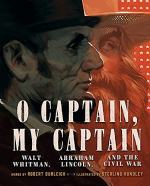
|
| Name: _________________________ | Period: ___________________ |
This quiz consists of 5 multiple choice and 5 short answer questions through Section 1: "O Captain! My Captain!" lines 1-24.
Multiple Choice Questions
1. Which technique is evident in line 10, "Rise up—for you the flag is flung—for you the bugle trills"?
(a) Antithesis.
(b) Antimetabole.
(c) Antistrophe.
(d) Anaphora.
2. The poem's title and first line contain an example of which technique?
(a) Personification.
(b) Synechdoche.
(c) Simile.
(d) Apostrophe.
3. Which is the best interpretation of line 9, when the speaker urges "O Captain! my Captain! rise up and hear the bells"?
(a) The speaker realizes that the captain is not actually dead yet.
(b) The speaker is addressing the captain's spirit or ghost.
(c) The speaker is having trouble accepting what has happened.
(d) The speaker is not yet aware that the captain has died.
4. What type of rhyme is employed in line 20, "From fearful trip the victor ship comes in with object won"?
(a) Eye rhyme.
(b) Internal rhyme.
(c) Identical rhyme.
(d) Near rhyme.
5. In the second quatrain of the second stanza, what becomes clear about the speaker's state of mind?
(a) He is actually asleep and only dreaming of the captain's death.
(b) He hopes to hide the captain's death from the crowd.
(c) He is afraid that he is in some way responsible for the captain's death.
(d) He has not fully accepted the captain's death.
Short Answer Questions
1. The list of ways the crowd is celebrating the arrival of the ship in lines 9-12 is an example of which technique?
2. What is the most accurate way to describe the poem's stanza form?
3. In context, the literal meaning of the word "rack" in line two is which of the following?
4. Line 4, "While follow eyes the steady keel, the vessel grim and daring," contains examples of which techniques?
5. What does the phrase "swaying mass" refer to (line 12)?
|
This section contains 312 words (approx. 2 pages at 300 words per page) |

|




